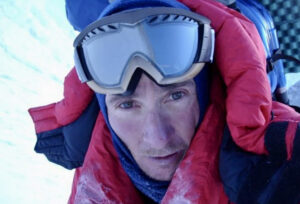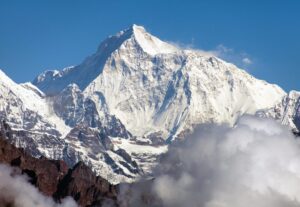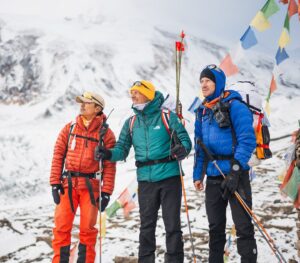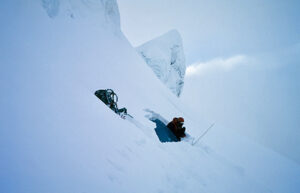In the 1980s, the winter 8,000’ers were the battlefield for tough Polish climbers universally admired for their determination, skill, discipline, and endless capacity for suffering. These so-called Ice Warriors achieved the first winter summits of seven of the 14 8,000’ers between 1980 and 1988.
The few international teams who tried to follow the Poles had little success. Eighteen years passed with no new winter summit on the highest peaks of the world.
At the turn of the millennium, Tibet’s Shishapangma was one of those seven unclimbed winter 8,000’ers. Permits were difficult to obtain, logistics were expensive, and the normal route in winter was too dangerous because of fierce winds and avalanches.
The alternative was the steeper south face, a technical climb requiring good alpine skills but also sunnier and sheltered from the wind. There were two failed attempts in the 2003-04 season. Finally, Shishapangma was summited twice the following year, in December 2004 and January 2005. Both climbs used no Sherpa support or supplemental oxygen.

The South Face of Shishapangma in winter. Photo: Simone Moro
New era
In 2004, the Poles returned to the winter 8,000’ers. Rather, a younger generation of Poles did. The most veteran in the 2003-4 team, Darek Zaluski, had been among the youngest in some of the earlier expeditions. The rest were strong, driven climbers but without winter Himalayan experience.
This time, a foreigner joined the team. Simone Moro of Italy already had a promising career and had summited some of the highest peaks, including a dramatic previous experience on Winter Annapurna. Here, his good friend Anatoli Boukreev died in an avalanche that nearly killed Moro as well.
As Bernadette McDonald points out in her book Winter 8000, Zaluski thought the presence of the famous Italian climber gave some prestige to their expedition. It made winter Himalayan climbing more interesting to the international community. The Poles, McDonald pointed out, tended to downplay their accomplishments.

Piotr Morawski during the 2004 winter Shishapangma expedition. Photo: mountain.ru
Moro, together with Piotr Morawski, reached the highest point (7,700m) on a summit attempt that they eventually aborted because of the late hour and increasing winds. Undeterred, the Polish-Italian team returned to Shishapangma the following winter, only to find out someone had already been there.
Enter Jean Christophe Lafaille
Jean Christophe Lafaille of France had become one of the most important characters in the 8,000’ers scene. A regular in ExplorersWeb’s 8,000m coverage at that time, he usually shared permits with the likes of Ed Viesturs, Ueli Steck, Inaki Ochoa, Gerlinde Kaltenbrunner, and Denis Urubko. All of them were pursuing, more or less consciously, the 14 8,000’ers. But Lafaille wanted to achieve something more durable, something never done before. Winter and solo were his key ingredients.
Lafaille traveled to Tibet in November 2004 with his wife. They reached Base Camp by the South Face of Shishapangma on Nov. 14. Lafaille acclimatized in the area, then launched a solo push that culminated in the summit on Dec. 11. He followed the British route and climbed a new variation on some sections.

Jean-Christophe Lafaille’s selfie on the summit of Shishapangma
Lafaille returned to claim the first winter ascent of Shishapangma. He supported his case by showing his winter permit from the China Tibet Mountaineering Association and explained how he had faced full-on winter conditions. While everyone applauded the bold ascent, few considered it a winter climb because he did it before the beginning of calendar winter. Meanwhile, Morawski and Moro stood on the summit some weeks later, on Jan. 14, and earned all the winter glory.
“Winter ascents on 8,000m peaks had almost been forgotten by then,” Simone Moro wrote last year, to commemorate the anniversary of that climb. “But with our first winter ascent of Shishpangma in 2005, Piotr Morawski and I rebooted the game and a new era began.”
A winter climb?
Lafaille’s summit never counted as a winter climb, and the French climber never forgot this for a second. Part of the problem was that Lafaille tried to claim too much. He called his a “first solo alpine style winter ascent” of Shishapangma.
Moro disputed this. He pointed out that Poland’s Krzysztof Wielicki had already soloed the face in 1993 (in only 24 hours!), while Lafaille’s ascent did not take place in winter because it was before the solstice. Moreover, it was not alpine style because the climber worked on the route previously and set some ropes.
“My dream was to prove that I was capable of climbing, without any support or artificial oxygen, a Himalayan big wall alone in winter conditions,” Lafaille told Alpinist magazine. “I’ve realized this dream today. I learned much from this ascent of Shishapangma, and next winter [I’ll attempt] a new voyage into the thin air and the cold of the Himalayan winter.”
Indeed, he had an even bigger goal in mind, something so bold that it would shut all mouths at once.
Lafaille’s final bet
In 2005-06, the year after the Shishapangma controversy, Lafaille headed to Makalu, alone. It was the only remaining Nepalese peak without a winter first ascent. At 8,481m, it was one of the five highest mountains on Earth. Furthermore, it had the reputation as a particularly tough peak due to the near-constant winds year-round.
Lafaille reached Base Camp on Dec. 18 and set off on his first foray up the mountain, to 6,000m, on Dec. 23.

Jean-Cristophe Lafaille. Photo: Mountain.ru
It was dangerous, and Lafaille liked that. The Independent quoted him saying:
In areas…where no modern technology can save you, you are reduced to your most basic and essential self. This natural space creates demanding situations that can lead to suffering and death, but also generate a wild interior richness. I try to live within their margins, in the narrow boundary between joy and horror. Everything on this earth is a balancing act.
Lafaille had a satphone to communicate with his wife. That was all the contact he had with other humans after he reached Advanced Base Camp.
Lafaille’s disappearance
Hurricane winds at the Makalu La thwarted Lafaille’s first summit attempt. He launched a second try on Jan. 24. He checked in three days later while camped on a ledge at 7,400m. From here, he planned to launch his final summit push later that day. And that was the last anyone heard from him.
There were no rescue options at the time. Helicopters were not as available then as they are now. Even a ground team was not an option, because of a lack of acclimatized climbers willing to face the mountain in the dead of winter.
When finally his wife managed to get a helicopter to scout the route on Feb. 4, there was no trace of him. Many years and many expeditions later, his body has never turned up. Veikka Gustafsson of Finland, a good friend of Lafaille and also present during the helicopter search, told author Bernadette McDonald that Lafaille had surely fallen into one of the crevasses that plagued the route.
Controversy rekindled with Gasherbrum I
As for the ongoing winter controversy, climbers have held different opinions but subsequent attempts take place either within calendar winter or in even stricter conditions, from Dec. 21 till the end of February. The debate surfaced again recently when Denis Urubko announced that he was going to climb Gasherbrum I in January 2024. He insisted if he succeeded, this would be a first winter climb of G1, according to the meteorological criteria that he adheres to, as Lafaille did.
This winter, Simone Moro is staying home in the Italian Alps, but he confirmed his point of view to ExplorersWeb.

A recent portrait of Simone Moro, posted on his Instagram account.
“I agree with Adam Bielecki [in an interview with ExplorersWeb] that no one will dispute the winter ascent of the Poles on March 9, 2012. It was so real-winter-cold that three other elite mountaineers died due to the harsh and extreme winter conditions.”
He is referring to Austrian Gerfried Goschl, Swiss Cedric Hahlen, and Pakistani Nisar Hussain Sadpara.
Moro also recalled the severe conditions on the first ascent of Winter Broad Peak on March 5, 2013, by Maciej Berbeka, Adam Bielecki, Tomasz Kowalski, and Artur Malek. Berbeka was on his third winter ascent, and Tomasz Kowalski never made it back to Base Camp.
Stop the debate
“I believe we should stop debating this ‘real winter season’ because it never ends,” Moro said. “We should not give credit to strange interpretations, or worse, cancel previous achievements. Manipulating history and changing the rules is not how to secure a place in history. However, Urubko might achieve a first solo ascent or the first alpine-style ascent of Winter Gasherbrum I.”
Moro insisted he still considers Urubko a friend, despite all the controversies. He wishes both Urubko on G1 and Alex Txikon on the “dangerous Annapurna” the best.
Currently, Txikon’s team is on its way to the summit of Annapurna, and Urubko is flying to Pakistan.
Simone Moro and Denis Urubko achieved Lafaille’s last dream, the first ascent of Winter Makalu, in 2009. By then, the two climbers were close friends and a superb climbing duo.






